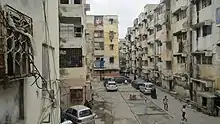
Housing in Pakistan generally consists of three classes: pakka houses (पक्का/پکّا pakkā, lit. '"ripe"'), which are made of strong materials like brick and cement; katchi houses (کچی kachē, lit. '"unripe, semi-made, unsure"'), which are made of less-permanent materials such as thatch and bamboo; and semi-pakka houses (these make up, which are a sort of mix of the pakka and katchi houses.[1] Housing in Pakistan has always been insufficient due to a growing population (which is 241.49 million as per the 2023 Pakistani Census)[2] and accelerated by urbanisation combined with the housing problem being low-priority in the eyes of the government.[1][3] Housing is an important element of real estate in Pakistan.
Housing shortage and deficit
Urban areas were facing a shortage of 4.4 million housing units in 2010, while the population is expected to grow by 40 million in 2030.[4] Furthermore, this shortage is expected to grow due to a shortfall of 270,000 housing units per year.[5] In Pakistan, past trends indicate that the increase in housing stock (146 percent increase) lagged far behind the population growth (209 percent increase) during 1960-1998, leading to overcrowding in housing units. The growth of housing in urban areas was far more rapid as compared to rural areas; 253 percent and 115 percent respectively. The habitation density level equals more than three people per room, which is significantly higher than the tolerable crowding level proposed by the United Nations; 1.4 to 2.0 individuals per room.[6] Urban crowding, specifically, has been accelerated by people from less-developed rural areas moving to cities to achieve better qualities of life.[7]
Housing finance in Pakistan
Housing financing is an important driver of housing in Pakistan and many banks are offering loans for house construction.[8]
See also
References
- 1 2 "Pakistan - Housing". Encyclopedia Britannica. Archived from the original on 2021-07-24. Retrieved 2021-07-21.
- ↑ "Pakistan's population soars to 241.49mln in digital census 2023". 2023-08-07. Retrieved 2023-09-30.
- ↑ Story, Pakistan's Growth (2019-03-28). "The Case of Affordable Housing". Pakistan's Growth Story. Archived from the original on 2021-07-21. Retrieved 2021-07-21.
- ↑ "How to manage urban growth in Pakistan". blogs.worldbank.org. Archived from the original on 2021-07-21. Retrieved 2021-07-21.
- ↑ "Affordable Housing in Pakistan". Reall—Affordable Housing Charity. Archived from the original on 2021-07-21. Retrieved 2021-07-21.
- ↑ Haq, Ms. Rashida. "Quantity and Quality of Housing Conditions" (PDF). Benazir Income Support Programme. Archived (PDF) from the original on 4 July 2021. Retrieved 24 July 2021.
- ↑ "How do we solve the housing crisis in Pakistan?". The Nation. 2019-03-18. Archived from the original on 2019-05-03. Retrieved 2021-07-24.
- ↑ Malik, Sana; Roosli, Ruhizal (2022), Kundu, Amitabh; Ponce Dentinho, Tomaz; Magsi, Habibullah; Basu, Kanika (eds.), "Appraisal of Housing Finance in Pakistan for Low-Income Groups: Concepts and Processes", Accessible Housing for South Asia: Needs, Implementation and Impacts, Cham: Springer International Publishing, pp. 297–308, doi:10.1007/978-3-030-88881-7_17, ISBN 978-3-030-88881-7, retrieved 2023-10-01
- POETIC LICENCE: Low-cost cities: an innovative new concept for urban development Daily Times (Sunday, November 24, 2002)
- Low-cost housing facility for poors top priority: Governor © 2007 Associated Press of Pakistan
- Proposal for the Construction of Low Cost Housing at Ibrahim Hydery, Karachi by Nadir Mansoor et al.